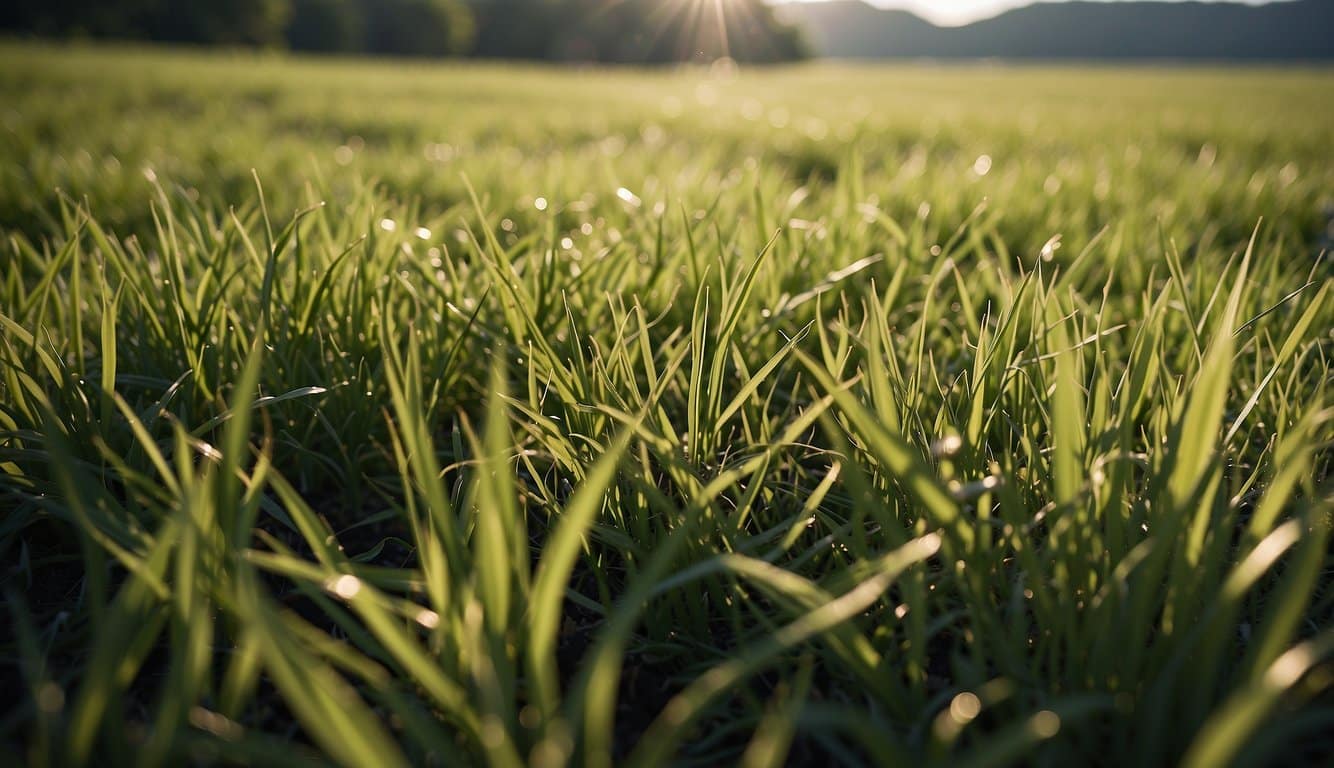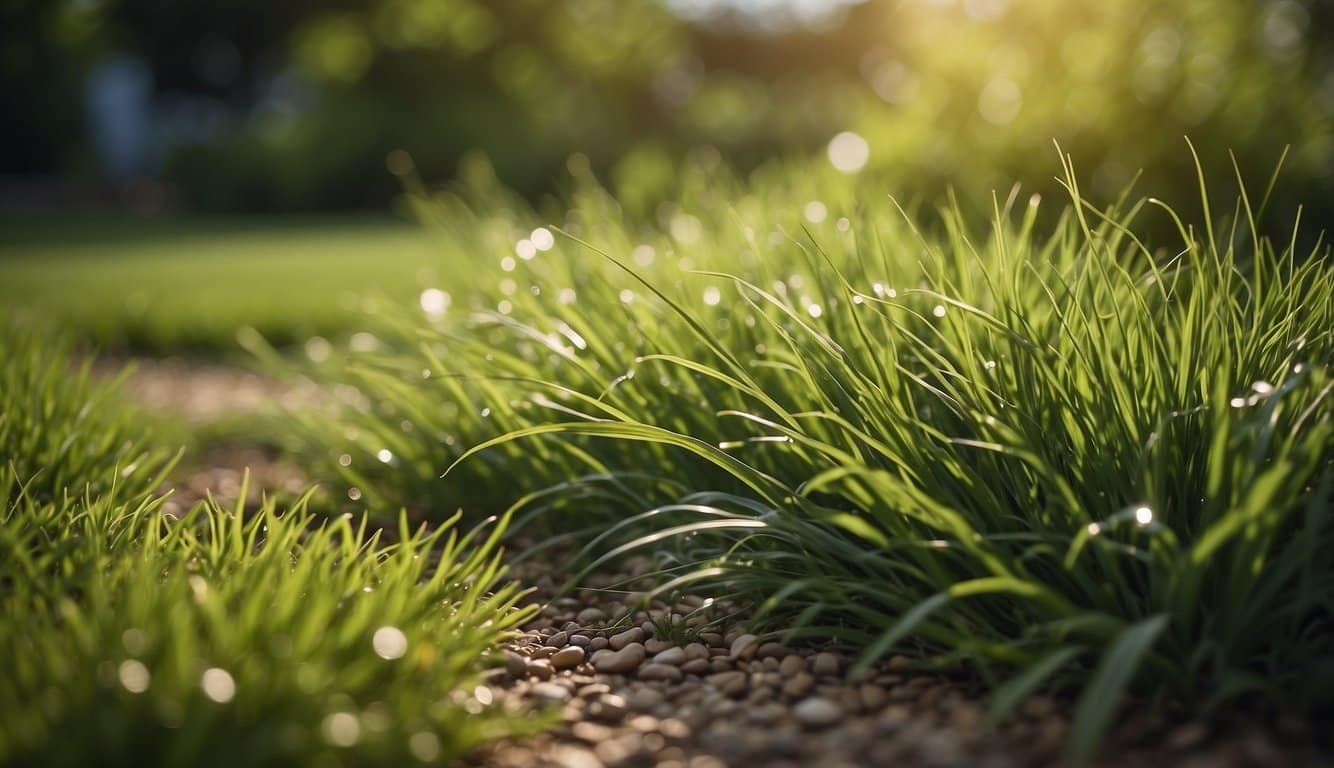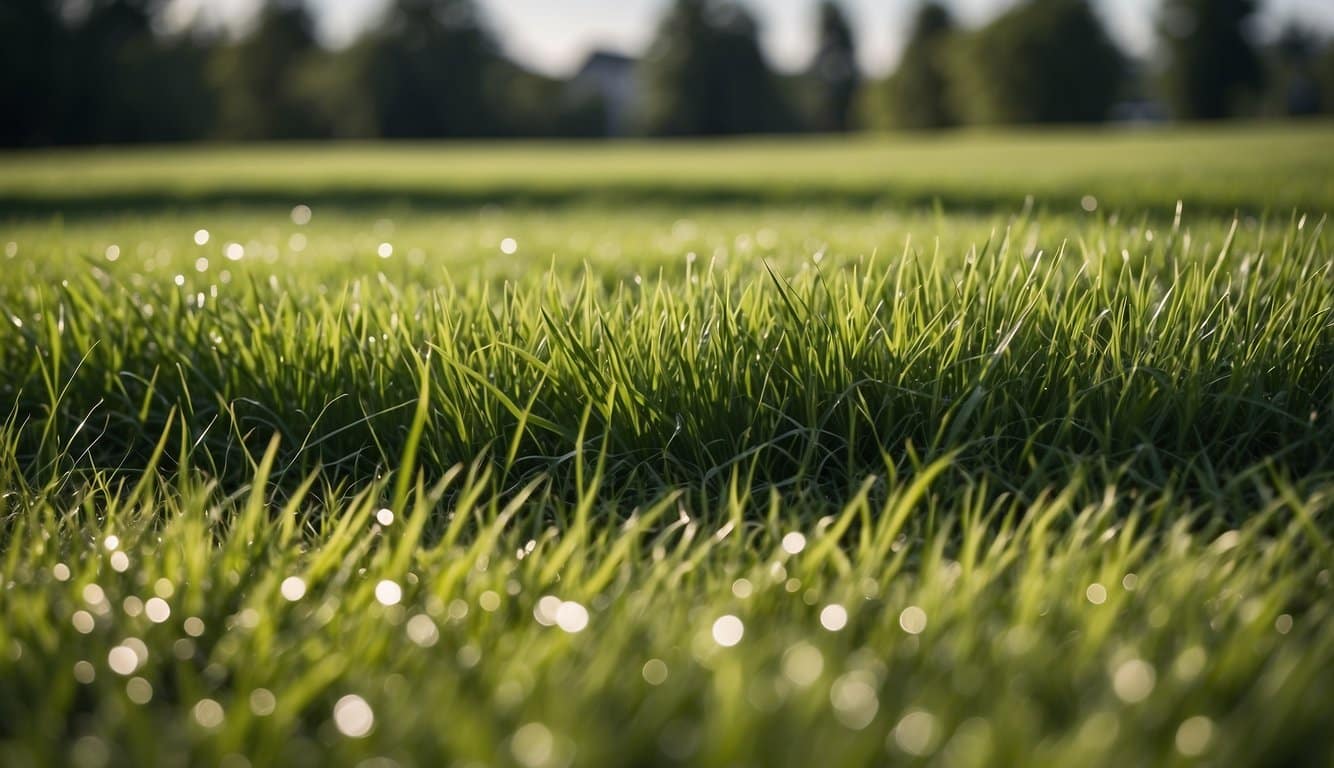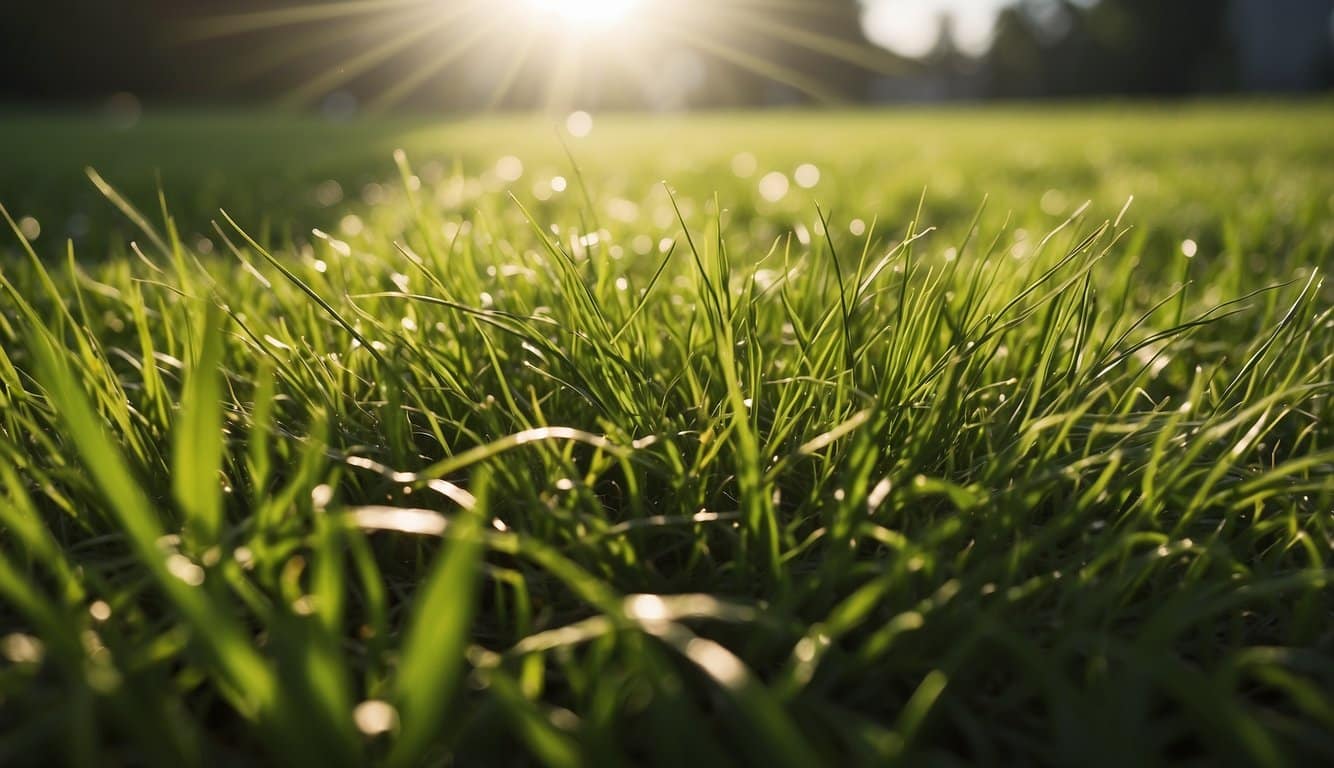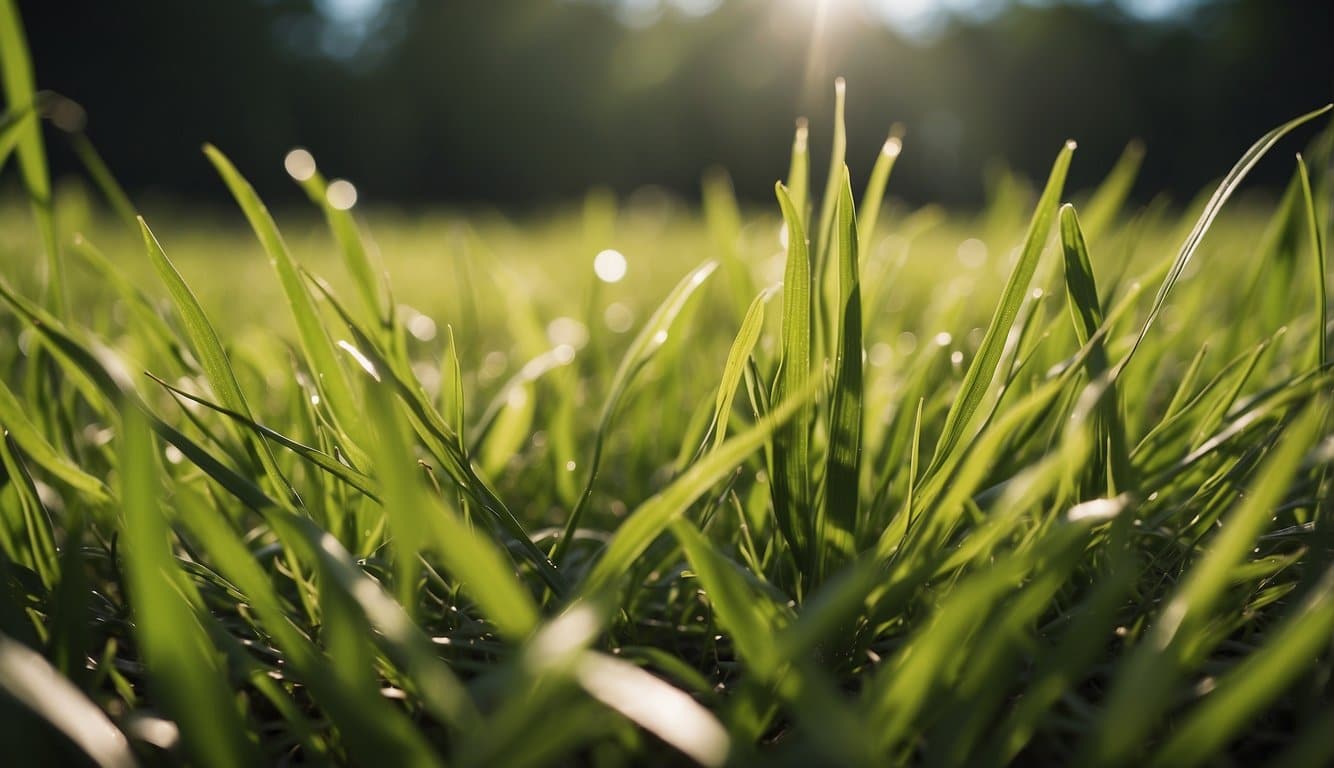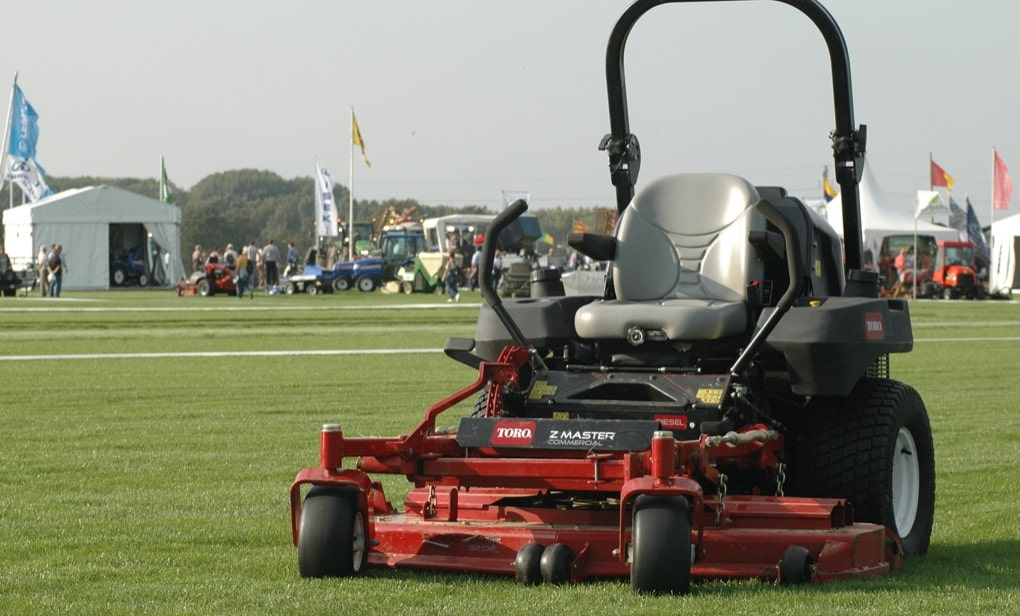Missouri’s diverse climate sets the stage for a variety of grasses to thrive, each adapted to the unique conditions of the state.
In Missouri, you can find both warm-season and cool-season grasses, thanks to its transitional climate. Warm-season grasses, such as Zoysia and Bermuda, thrive in the southern parts of Missouri, where the summers are longer and warmer.
Cool-season grasses, like Kentucky Bluegrass, Tall Fescue, and Perennial Ryegrass, do well in the northern and central regions, benefiting from cooler temperatures and adequate moisture.
Missouri is considered a transition zone. This means it doesn’t strictly fall into either the warm-season or cool-season category. Instead, it straddles both, allowing for a diverse range of grass types to be grown. The key to a successful lawn in Missouri is selecting a grass type that matches your local climate, soil conditions, and maintenance preferences.
Understanding Missouri’s Climate and Soil
Missouri is located in the Midwestern region of the United States and is known for its continental climate.
The state experiences four distinct seasons, with hot and humid summers and cold and dry winters.
The climate can vary significantly across the state due to its diverse topography, which includes plains, rolling hills, and the Ozark Mountains.
The varying soil types in Missouri can also pose a challenge for growing grass. The state’s soil can range from heavy clay to sandy loam, which can make it difficult to find the right grass seed that will thrive in a specific area.
It is important to understand the soil type in your area before selecting a grass seed.
One grass seed that works well in most of Missouri is tall fescue. This turfgrass is known for its heat and drought resistance and can tolerate high temperatures.
It is a great general-purpose grass seed that can be developed by seed or sod.
Another factor to consider when planting grass in Missouri is the timing. Late August to mid-October is ideal for spring planting in Missouri due to warm soil temperatures for cool-season grass seed.
The warmth promotes faster germination, aiding the grass seed’s growth and establishment.
| Climate | Soil |
|---|---|
| Hot and humid summers | Heavy clay to sandy loam |
| Cold and dry winters | Varying soil types |
| Four distinct seasons | Diverse topography |
Note: The information provided is based on research and may vary depending on specific locations within Missouri.
Grass Selection for Missouri Lawns
When it comes to selecting grass for Missouri lawns, there are two main categories to consider: cool-season grasses and warm-season grasses. Each category has its own unique features and benefits that make it suitable for different lawn types.
Cool-Season Grasses
Cool-season grasses are the most common type of grass found in Missouri lawns. They thrive in cooler temperatures and are best suited for areas with moderate to high shade.
Some of the most popular cool-season grasses for Missouri lawns include:
- Tall Fescue: This grass is known for its durability and adaptability to different soil types. It has a deep root system that allows it to tolerate drought and high temperatures.It is also resistant to disease and pests, making it a great choice for low-maintenance lawns.
- Kentucky Bluegrass: This grass is known for its fine texture and rich, green color.It is best suited for areas with moderate to high shade and has a moderate tolerance for drought. It requires regular watering and fertilization to maintain its lush appearance.
Warm-Season Grasses
Warm-season grasses are best suited for areas with hot summers and mild winters, making them ideal for southern Missouri lawns. They are known for their drought tolerance and ability to thrive in full sun.
Some of the most popular warm-season grasses for Missouri lawns include:
- Bermudagrass: This grass is known for its dense, low-growing turf and ability to tolerate high traffic.It is best suited for areas with full sun and has a high tolerance for drought. It requires regular mowing and fertilization to maintain its appearance.
- Zoysia Grass: This grass is known for its fine texture and ability to tolerate shade and drought.It is best suited for areas with moderate to high shade and has a moderate tolerance for traffic. It requires regular watering and fertilization to maintain its lush appearance.
Lawn Preparation and Grass Planting
Before planting grass, it is essential to prepare the lawn properly. This section will cover the necessary steps to take before planting grass seeds in Missouri.
Soil Preparation
The first step in lawn preparation is to test the soil. Soil testing is essential to determine the pH level and nutrient content of the soil.
The soil test results will guide the application of fertilizer and lime, which are necessary for optimal grass growth.
To prepare the soil, remove any debris, rocks, or weeds from the area. Then, till the soil to loosen it and create a smooth surface for planting.
If the soil is compacted, aerate it to improve water and nutrient penetration.
Grass Selection
Choosing the right grass type for your lawn is crucial for its success.
Missouri’s climate is ideal for cool-season grasses such as Kentucky bluegrass, tall fescue, and fine fescue. These grasses are drought-tolerant and can withstand the state’s hot summers and cold winters.
When selecting grass seeds, consider the lawn’s use and the amount of sunlight and shade it receives. Kentucky bluegrass is suitable for high-traffic areas, while fine fescue is ideal for shaded areas.
Planting Grass Seeds
The best time to plant grass seeds in Missouri is in the fall, between late August and early October. This period is ideal because the soil is warm, and there is ample rainfall for seed germination.
Before planting, spread the grass seeds evenly over the soil surface. Then, lightly rake the soil to cover the seeds with a thin layer of soil.
Water the area frequently to keep the soil moist but not waterlogged.
Watering Guidelines for Healthy Grass
Keeping a lush, green lawn in Missouri requires proper watering techniques. Here are some guidelines to follow for healthy grass:
1. Water Deeply and Infrequently
It’s better to water your lawn deeply and infrequently rather than frequently and shallowly. This encourages the grass roots to grow deeper, resulting in a healthier and more drought-resistant lawn.
A good rule of thumb is to water your lawn once a week, providing it with 1 inch of water.
2. Water Early in the Morning
Watering your lawn early in the morning is the best time of day to do it.
This is because the temperature is cooler and the wind is usually calmer, which allows the water to penetrate the soil and reach the roots of the grass. Watering in the evening can lead to fungal diseases, as the grass blades may stay damp overnight.
3. Use a Sprinkler System
Using a sprinkler system is an efficient way to water your lawn.
It’s important to make sure the sprinkler heads are adjusted correctly to avoid watering sidewalks and driveways. Consider investing in a sprinkler timer to ensure your lawn is watered on a consistent schedule.
4. Check Local Watering Restrictions
It’s important to check local watering restrictions in your area before watering your lawn.
In some areas, there may be certain days or times when watering is not allowed. It’s important to follow these restrictions to avoid fines and conserve water.
Fertilizing and Soil Management
Maintaining a healthy lawn in Missouri requires proper fertilization and soil management.
The optimal pH range for growing turfgrasses is 6.0 to 7.0. Most Missouri soils are slightly acidic and in the range of 5.0 to 7.0. A balanced availability of plant nutrients is found in the pH range of 6.0 to 7.0.
Therefore, it is important to conduct a soil test to determine the pH level of the soil and the nutrient deficiencies present.
Based on the soil test results, select a lawn fertilizer that has the appropriate ratio of nitrogen, phosphorus, and potassium.
Without a soil test, use a lawn fertilizer with an approximate ratio of 1:1:1 to 2:1:1 or 3:1:2 (nitrogen:phosphorus). For example, a 3:1:2 fertilizer would have a label analysis of 21-7-14.
The timing of fertilizer applications must match the type of grass (warm- or cool-season) that is being managed.
For cool-season grasses such as Kentucky bluegrass, perennial ryegrass, tall fescue, and fine fescue, the best time to fertilize is in the fall. Fertilizing in the fall promotes root growth and helps the grass to store nutrients for the winter.
For warm-season grasses such as zoysia and Bermuda grass, the best time to fertilize is in the spring and summer.
In addition to fertilization, proper soil management is crucial for maintaining a healthy lawn.
Soil compaction can prevent water and nutrients from reaching the roots of the grass. Aeration is a process that can alleviate soil compaction by creating small holes in the soil.
This allows water and nutrients to penetrate the soil and reach the roots of the grass. Aeration can be done in the fall or spring, depending on the type of grass and the soil conditions.
Common Lawn Pests and Diseases
Maintaining a healthy lawn can be challenging, especially when dealing with pests and diseases. In Missouri, various insect pests and fungal diseases can cause damage to grass, resulting in thinning, discoloration, and even death. Here are some common lawn pests and diseases in Missouri:
Insect Pests
Insects can cause significant damage to lawns, especially during their active season. Here are some of the most common insect pests in Missouri:
- White Grubs: These are the larvae of beetles, such as Japanese beetles and June bugs. They feed on grass roots, causing brown patches on the lawn.Signs of white grubs include wilting grass and the presence of birds, raccoons, or skunks digging up the lawn to feed on them.
- Chinch Bugs: These tiny insects suck the sap from grass blades, causing yellowing and browning. They are most active during hot and dry weather conditions.
- Sod Webworms: These caterpillars feed on grass blades, causing brown patches and uneven growth. They are most active during the summer months.
Fungal Diseases
Fungal diseases can also cause damage to lawns, especially when the weather is warm and humid. Here are some common fungal diseases in Missouri:
- Brown Patch: This disease is characterized by circular brown patches on the lawn, with a ring of green grass around them. It is caused by a fungus that thrives in warm and humid weather.
- Powdery Mildew: This disease appears as a white powder on grass blades, causing them to turn yellow and brown. It is most common in shaded areas and during humid weather.
- Dollar Spot: This disease causes small, circular brown patches on the lawn, with a silver dollar-sized lesion in the center. It is caused by a fungus that thrives in warm and humid weather.
Lawn Maintenance Through the Seasons
Maintaining a lush green lawn in Missouri requires regular care and attention throughout the year. By following these tips for each season, homeowners can keep their grass healthy and vibrant.
Spring Care
Spring is the perfect time to start preparing the lawn for the growing season ahead. Here are a few tasks that should be done during spring:
- Rake and remove any debris, such as leaves or twigs, that accumulated over the winter.
- Aerate the soil to allow water, air, and nutrients to penetrate the roots.
- Apply a pre-emergent herbicide to prevent weeds from taking over the lawn.
Summer Care
Summer is the time when the lawn is in full growth mode. Here are a few tips for maintaining a healthy lawn during the summer months:
- Water the lawn deeply and infrequently to encourage deep root growth.
- Mow the lawn regularly, but avoid cutting it too short, as this can stress the grass.
- Apply a balanced fertilizer to promote healthy growth and help the lawn withstand heat and drought.
Fall Care
Fall is the time for the lawn to recover from the stress of summer and prepare for the winter. Here are a few tasks that should be done during fall:
- Continue to water the lawn deeply and infrequently, but reduce the frequency as the weather cools.
- Aerate the soil again to loosen any compacted soil and allow for better water and nutrient absorption.
- Apply a fall fertilizer to promote root growth and help the lawn survive the winter.
Winter Care
Winter is a time of dormancy for the lawn, but there are still a few things that can be done to help it survive the cold weather:
- Keep the lawn free of debris, such as fallen branches or leaves, as they can smother the grass.
- Avoid walking on the lawn when it is covered in snow or frost, as this can damage the grass blades.
- Apply a winter fertilizer to provide the lawn with the nutrients it needs to survive until spring.
Mowing and Aeration Best Practices
Maintaining a healthy lawn requires proper mowing and aeration practices. In Missouri, mowing should be done regularly during the growing season to keep the grass at an appropriate height of 2-3 inches. This helps the grass develop a strong root system and promotes healthy growth.
It is important to avoid cutting the grass too short, as this can damage the roots and cause the grass to become stressed.
Aeration is also an essential practice for maintaining a healthy lawn.
This process involves perforating the soil with small holes to allow air, water, and nutrients to penetrate the grass roots. Aeration helps to reduce soil compaction, which can inhibit root growth and lead to a thin, unhealthy lawn.
It also helps to break down thatch, which is a layer of dead grass and other organic material that accumulates on the soil surface.
In Missouri, the best time to aerate cool-season grasses such as Kentucky bluegrass, perennial ryegrass, and fine fescue is during the fall or spring.
This allows the grass to recover quickly and take advantage of the increased nutrients and moisture in the soil. For warm-season grasses such as zoysia and Bermuda grass, aeration should be done during the late spring or early summer.
When mowing and aerating, it is important to follow best practices to avoid damaging the grass. Here are some tips to keep in mind:
- Use a sharp mower blade to avoid tearing the grass.
- Mow in different directions each time to prevent the grass from leaning in one direction.
- Avoid mowing when the grass is wet, as this can lead to clumping and uneven cutting.
- When aerating, use a machine with hollow tines to remove plugs of soil, rather than a spike aerator which can cause further compaction.
- After aerating, consider topdressing the lawn with compost or sand to help fill in the holes and improve soil quality.
Eco-Friendly Lawn Alternatives and Landscaping
When it comes to maintaining a beautiful lawn, many homeowners turn to traditional grass lawns. However, there are several eco-friendly alternatives that can help reduce water usage, minimize chemical treatments, and support local ecosystems. In this section, we’ll explore some of the best eco-friendly lawn alternatives and landscaping options for Missouri homeowners.
Native Plants
Native plants are a great alternative to traditional grass lawns. These plants are naturally adapted to the local climate, soil, and wildlife, making them easier to maintain and more resilient to pests and diseases.
Plus, they provide important habitat and food sources for local pollinators and birds.
Groundcovers
Groundcovers are low-growing plants that spread quickly and provide a dense, weed-resistant cover.
They are a great option for areas where grass is difficult to grow, such as shady spots or steep slopes. Some popular groundcovers for Missouri include creeping thyme, sedum, and creeping phlox.
Rain Gardens
Rain gardens are designed to capture and filter rainwater, reducing runoff and improving water quality. They are typically planted with a mix of native grasses, flowers, and shrubs, creating a beautiful and functional landscape feature.
Rain gardens are particularly useful in areas with poor drainage or erosion issues.
Mulch and Gravel
Mulch and gravel are low-maintenance options that can be used to create a beautiful and eco-friendly landscape. They can be used to cover bare soil, suppress weeds, and retain moisture.
Plus, they come in a variety of colors and textures, making it easy to create a unique and attractive landscape design.
Hardscapes
Hardscapes are non-living elements of a landscape design, such as paths, walls, and patios. They can be made from a variety of materials, including stone, brick, and concrete.
Hardscapes are a great option for areas where grass is difficult to grow or maintain, and they can add visual interest and functionality to a landscape design.
Frequently Asked Questions
What is the optimal grass seed for areas with clay soil in Missouri?
Clay soil in Missouri is known to be dense and compact, which can make it difficult for grass to grow. However, there are some grass varieties that can thrive in these conditions.
The best grass seed for clay soil in Missouri is a mix of tall fescue and Kentucky bluegrass. These grasses are known for their deep root systems, which help them to penetrate through the clay soil and reach the necessary nutrients.
Which grass variety is most suitable for high-traffic areas with pets in Missouri?
For high-traffic areas with pets in Missouri, it is recommended to use a grass variety that is durable and can withstand the wear and tear of constant use.
Bermuda grass is an excellent option for these areas, as it is known for its ability to recover quickly from damage. Additionally, Bermuda grass is resistant to pet urine, which can be a common problem in these areas.
How does Zoysia grass perform in the Missouri climate?
Zoysia grass is a warm-season grass that is well-suited to the hot and humid climate of Missouri. It is known for its ability to withstand drought and heat, making it an excellent choice for areas that experience high temperatures.
Additionally, Zoysia grass is resistant to disease and pests, which can be a common problem in Missouri.
What is the recommended schedule for lawn seeding and maintenance in Missouri?
In Missouri, the best time to seed a lawn is in the fall, between mid-September and early November. This allows the grass to establish itself before the winter months.
For maintenance, it is recommended to mow the lawn regularly, but not too short, as this can stress the grass. Additionally, watering should be done deeply and infrequently, rather than frequently and shallowly.
Which grass species thrive best in both sunny and shaded areas in Missouri?
If you have a mix of sunny and shaded areas in your lawn, it is recommended to use a grass mix that includes both sun-loving and shade-loving species.
A mix of tall fescue and fine fescue is a good option for these areas, as it is known for its ability to grow well in both sun and shade.
What are the essential steps for achieving a healthy lawn in Missouri?
To achieve a healthy lawn in Missouri, it is important to follow a few essential steps.
First, choose the right grass variety for your area and soil type.
Second, make sure to seed and maintain your lawn properly, including regular mowing and deep, infrequent watering.
Finally, be sure to fertilize your lawn regularly and address any pest or disease issues promptly.
Last update on 2025-06-06 / Affiliate links / Images from Amazon Product Advertising API



